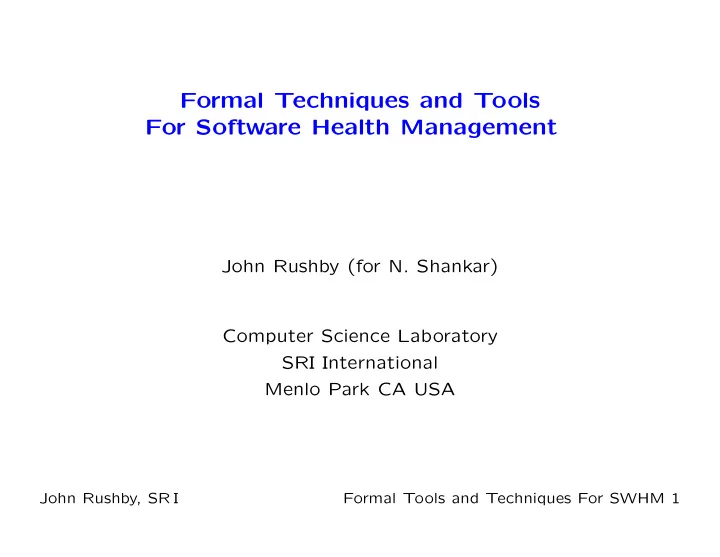

Formal Techniques and Tools For Software Health Management John Rushby (for N. Shankar) Computer Science Laboratory SRI International Menlo Park CA USA John Rushby, SR I Formal Tools and Techniques For SWHM 1
Introduction • New project, just a few weeks old • PI is Shankar, but he’s at a conference in Korea ◦ I’m a Co-Investigator, • I was a member of the NRC Committee whose report ”Sufficient Evidence” is cited in the NRA • Report mentions Assurance/Dependability/Safety Cases • I will talk about these tomorrow in IRAC track at 8am • But, briefly. . . John Rushby, SR I Formal Tools and Techniques For SWHM 2
Assurance Cases • Intellectual basis for all assurance surely rests on ◦ Claims or Goals, Evidence, Argument • Standards-based assurance (e.g., DO-178B) specifies only the evidence to be produced ◦ Claims and argument are largely implicit • Assurance case: make all three items explicit ◦ And also your confidence in each John Rushby, SR I Formal Tools and Techniques For SWHM 3
Our Project, Generalities • Health monitoring implies online checking • We know how to do this (cf. Grigore Rosu) • But what (source of) properties to monitor? • Low Level SW requirements unlikely to be useful ◦ DO-178B ensures these are implemented correctly • Similarly with High Level SW requirements • Most likely it’s the requirements that are in error • We need an independent source of properties to monitor • Aha: the Assurance Case John Rushby, SR I Formal Tools and Techniques For SWHM 4
Our Project, Particularities • Derive monitors from formalized assurance cases • Also monitor SW against its own history ◦ Cf. anomaly detection ◦ Identifies untested/novel scenarios • Diagnosis: classical model-based • Recovery/repair: first, use existing redundancy • Then, controller synthesis against the model ◦ With explicit cognitive models of human operators • Can do this because we have enormously powerful deductive systems ◦ SMT solvers and their kin • For more details, Google my paper “Runtime Certification” John Rushby, SR I Formal Tools and Techniques For SWHM 5
Two Big Questions • Architectural principles • Composability (specifically, compositional certification) • Profound insight (Tim Kelly): ◦ The assurance case may not decompose along architectural lines • So what is an architecture? • A good one supports and enforces the assurance case • Cf. MILS approach to security: next week at DASC ◦ Explicitly compositional ◦ Relates to IMA John Rushby, SR I Formal Tools and Techniques For SWHM 6
Guarding the Guardians • Fault tolerance is immensely hard • Homespun solutions generally make things worse • Our stuff will only kick in when existing fault tolerance and the certification process have failed • So, we should have some humility • Cf. AA 903 (1997): EFIS rebooted because roll rate was considered implausible ◦ But pilots were attempting recovery from major upset ◦ Loss of all instruments jeopardized this • OTOH, A340 fuel emergency (2005), and 777 (2005) and A330 (2008) ADIRU incidents near Perth probably could have been mitigated by good SWHM • Link to the assurance case seems the strongest guardian John Rushby, SR I Formal Tools and Techniques For SWHM 7
Recommend
More recommend